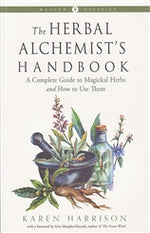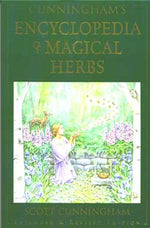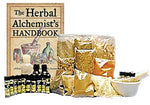© Copyright 2023 Karen Charboneau-Harrison, All Rights Reserved.
Herbs have been used for thousands of years in all cultures for both medicinal and magickal purposes. In this series of articles, herbs will be considered from both perspectives based on the western model codified by the herbalogist/astrologer/philosopher Paracelsus, planet by planet. Let us begin by considering the medicinal and energy properties of the Solar Herbs.
In medicinal terms, the Sun could be considered the Great Restorative. Even as the returning sun allows plant life to flourish on the earth, the herbs attributed to the Sun act, each in their own fashion, to restore metabolic vitality and to stimulate and balance a system suffering from either excess or deficiency. Many of the plants, of course, may be considered Solar simply on the basis of appearance. Chamomile, Celandine, St. John's Wort and Calendula all produce bright yellow flowers, many of which blossom around the Summer Solstice. The Sunflower follows the path of the Sun during the day, facing the east as the Sun rises and bending its head to the west as the Sun sets. Saffron produces the bright yellow-gold dye that may be considered Solar in effect.
It is in healing, however, that the Solar herbs exemplify their beneficial attributions. The effects of solar herbs restore equilibrium to the entire physical system, often serving as tonics to the heart and in the promotion the free flow of vital energy. The heart is commonly considered the solar center of the body (the organ ruled by Leo with the Sun as the planet attributed to Leo) and many effects of solar herbs center around this organ. Angelica relieves circulatory conditions, such as gout, when used as a compress, as well as fever, inflammations and headache (all conceivable symptoms of excess heat or high blood pressure). St. John's Wort relieves headaches while Chamomile and Celandine reduce fever. Chamomile, Celandine, Juniper and St. John's Wort also relieve swellings, inflammations and rheumatic conditions which tie in with the use of Eyebright and St. John's Wort to relieve symptoms due to colds (the application of restorative, solar heat on rheumatic joints and congested lungs). Angelica and St. John's Wort also have restorative properties.
Mistletoe, parasite/symbiote to the oak, attributed in a wide variety of cultures to solar deities, produces a drastic and often fatal action on the heart and circulatory system. The berries are never used but the leaves and twigs can be made in a weak infusion to reduce bleeding by lowering blood pressure, and it can be used to reduce uterine bleeding after parturition. As one of the few spots of green in the forest in the dead of winter, the mistletoe is often viewed as a symbol of the sun and returning life.
Because the Sun is seen in astrology and magick as the planet of the ego or personality, the magickal/energy effects of the Solar herbs are to promote self confidence and personal success. The energies of Sun herbs are represented and expressed by people in the public eye - rulers and authority figures, as well as people in successful endeavors that give them much pleasure by personal self-expression. Sun herbs impart a sense of purpose and a strong will. Used in solar incenses, ritual oils, philters and other herbal formulas used in ritual, Sun herbs give vitality, health, creativity, dignity, success and authority. Traditional herbs of the Sun include Angelica, Ash, Bay, Chamomile, Celandine, Eyebright, Frankincense, Juniper, Mistletoe, Rosemary, Saffron, Safflower, St. John's Wort, Sunflower, Tormentilla, and Walnuts.
| Recommended Products | |
 Herbal Alchemists Handbook Herbal Alchemists Handbook |
 Cunninghams Encyclopedia of Magical Herrbs Cunninghams Encyclopedia of Magical Herrbs |
 Basic Herbal Sampler Basic Herbal Sampler |
 Basic Essential Oil Sampler Basic Essential Oil Sampler |
 Deluxe Essential Oil and Herbal Sampler Deluxe Essential Oil and Herbal Sampler |
|
